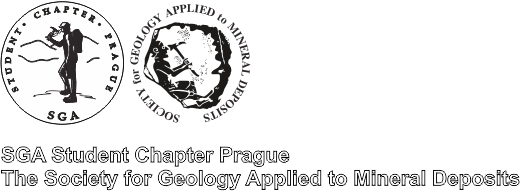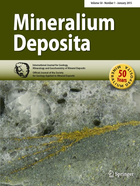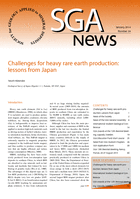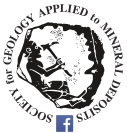Report from the Gold Short Course 2018 (led by Prof. David. I. Groves) + post-course field trip in Bohemian Massif
Jan Kulhánek, Marek Tuhý, Dominik Brém, Rafael Baieta
SGA Student Chapter Prague, Faculty of Science, Charles University, Albertov 6, 128 43 Prague 2, Czech Republic; jan.kulhanek@natur.cuni.cz
Photos album links:
Gold short-course: https://www.zonerama.com/SGA-Prague/Album/4347282
Post-Gold course Field trip: https://www.zonerama.com/SGA-Prague/583718
Short Course
During 19–20th of May 2018 the SGA Student Chapter Prague organized the Gold Short Course led by Prof. David I. Groves from the Centre for Exploration Targeting, UWA, Australia. There was an icebreaker organised in the Chlupáč’s Museum of Earth History in the Faculty of Science, which was a great opportunity to experience this newly established exposition with a glass of wine (Fig. 1). This event also took place in the Faculty of Science, Charles University, Prague, Czech Republic, where 77 participants from 13 countries and 6 SGA Student Chapters came to attend lectures by Prof. Groves (Fig. 2, 3).
David I. Groves is an Emeritus Professor at the University of Western Australia (UWA). He is considered to be a world leader in the research of ore deposits, particularly orogenic gold and IOCG deposits, and global metallogeny. On the UWA, he helped to establish the Centre for Exploration Targeting. He has authored and/or co-authored more than 500 publications, mainly in the fields of Archean evolution, komatiite-associated Ni-Cu deposits, orogenic gold deposits, the role of lithosphere in global metallogeny, and prospection mapping. He was elected President of the SGA, SEG and the Geological Society of Australia, and for his outstanding achievements during his career, he received both the SGA Newmont Gold Medal and the SEG Penrose Gold Medal.
Each day of the short course was focused on different topics within 4 lectures:
1st day – Orogenic gold deposits:
1st lecture: Introduction to orogenic gold
2nd lecture: The crustal continuum and genetic models for orogenic gold
3rd lecture: Critical factors controlling the formation of orogenic gold
4th lecture: Exploration targeting for orogenic gold
2nd day – Gold deposits on craton margins:
5th lecture: Introduction to intrusion-related gold deposits (IRGDs)
6th lecture: Nature of hybrid magmas and genesis of IRGDs
7th lecture: Carlin-type gold deposits of Nevada and China
8th lecture: Iron-oxide copper-gold deposits: nature and genesis
SGA Student Chapter Prague is grateful and would like to thank Prof. Groves for leading this short course and we would also like to thank all our sponsors who supported us during the organization of this event. Especially the SGA Educational Fund for the financial support and the bakery Kabát, butchery Göergl, company Vitana and brewery Staropramen for their excellent catering (Fig. 4).
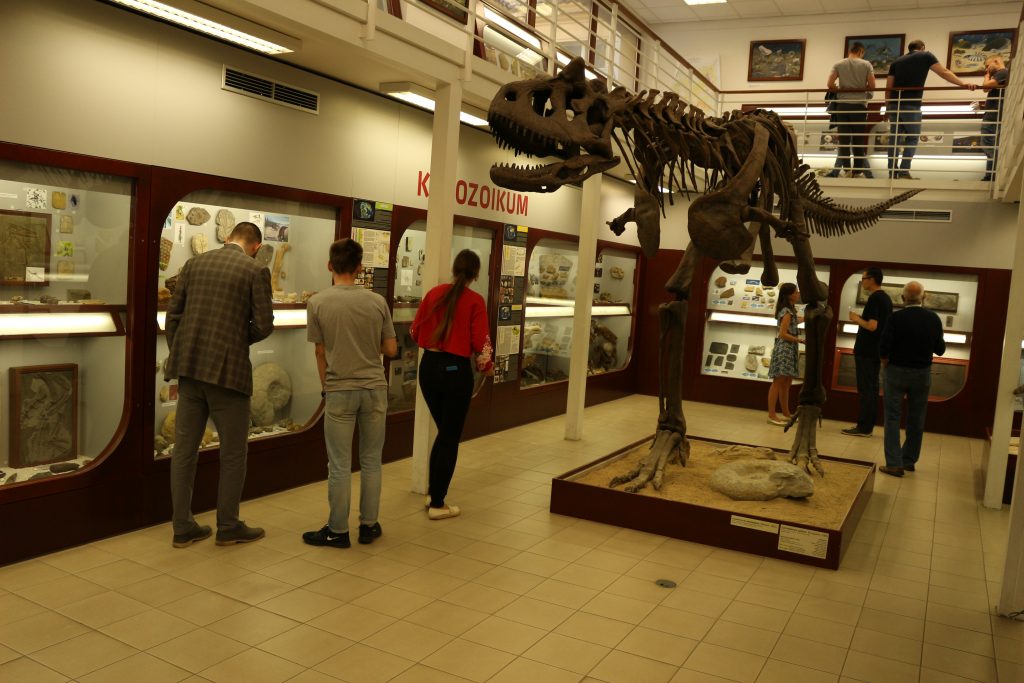
Fig.
1: Ice-breaker visits of Chlupáč’s Museum of Earth History. Photo
by V. Santolík.
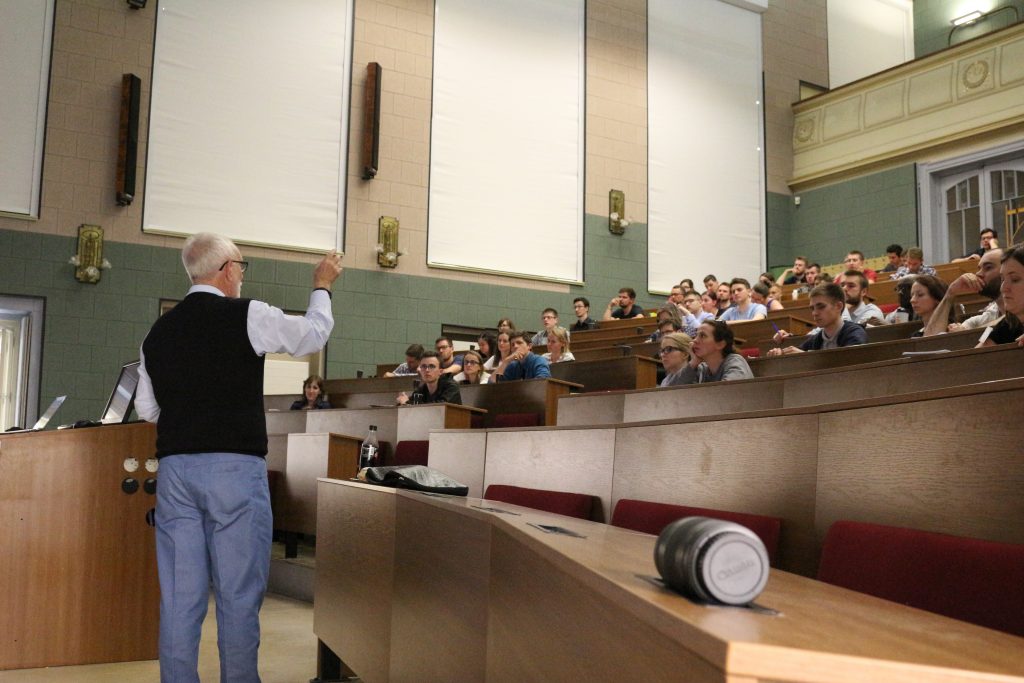
Fig.
2: Ongoing lecture by Prof. Groves. Photo by V. Santolík.
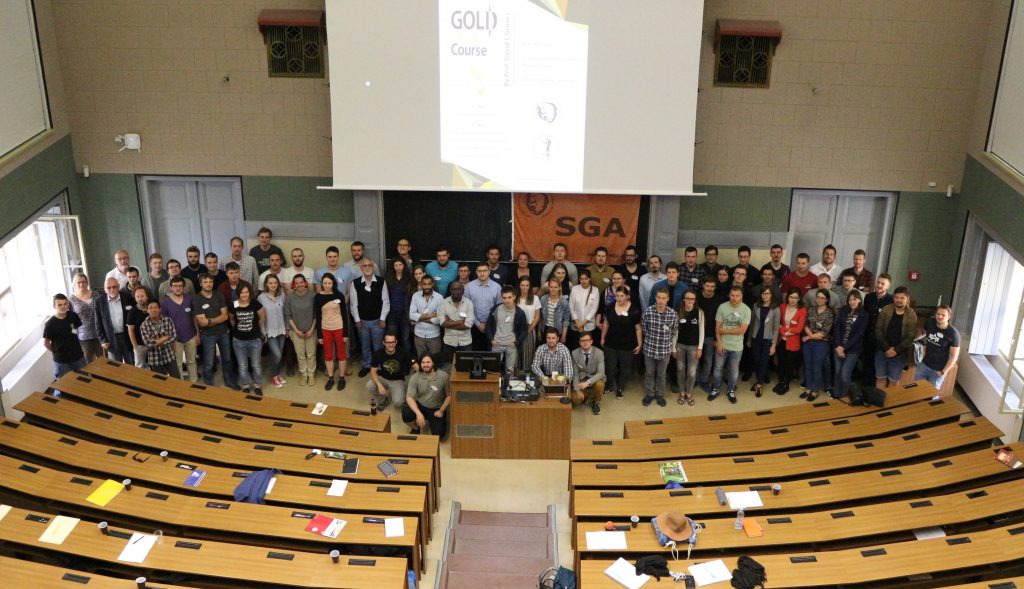
Fig. 3: Group photo of all participants by V. Santolík.

Fig.
4: Food provider Michal Čurda with refreshments and sponsors logo.
Photo by M. Tuhý.
Field trip
The post-course field trip took place during 21–23rd of May 2018 to various deposits in the Bohemian Massif. On this trip participated 14 SGA members, besides the Prague Chapter’s members also the Baltic, Black Forest and Moroccan members + SGA members without chapter.
1st day
We visited the Jílové gold district, which is characterized by three main types of gold-bearing ore bodies differing in morphology: ore veins representing the main type of mineralization mined in the past, gold-bearing stockworks representing the type of mineralization of greatest economic importance and stockworks of irregular shapes passing into impregnation zones which are developed at the eastern margin of the albite granite body between the Šlojíř and Kocoury vein zones, forming the Klobásy ore zone in the southern part of the Jílové district (Pepř mine). Firstly, we have visited two historical galeries, St. A. Paduán (Fig. 5) and St. Josef gallery, where it was possible to see historical styles of mining. Afterwards we moved to the more recent Pepř mine with Václav gallery which was finished during the second half of 19th century when the underground exploration of the southern part of the Jílové district occurred. Since 2012, this mine is under control of the Montanika society, who is removing the obstacles and taking care of the mine and to whom we would like to thank for an excellent visit, especially to the leader of this mine-tour Dr. Pavel Škácha (Fig. 6).

Fig.
5: Historical gallery St. A. Paduán. Photo by L. Kyrc.
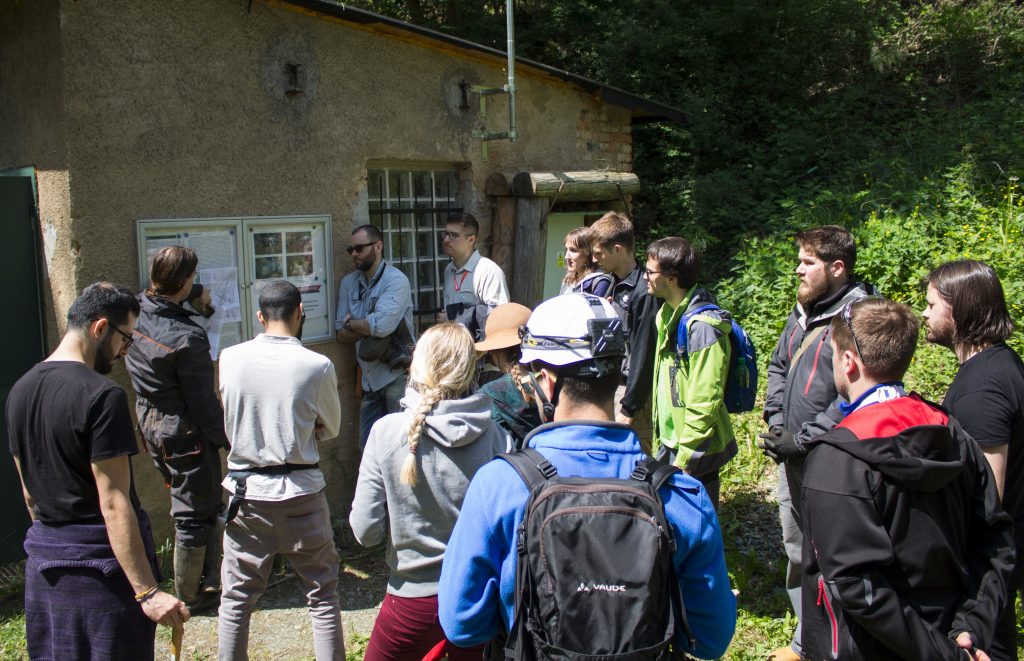
Fig.
6: Introduction speech by Dr. Škácha in front of Václav gallery.
Photo by L. Kyrc.
2nd day
We moved to the Krušné hory Mts. on the NW part of the Czech Republic and, in the morning, we visited the historical town Jáchymov, which is an old well-known mining district operating since 1511. In the beginning, silver was mined in secondary cementation zones and in 1519, the first Šlik’s Thaler was minted. This name was then transformed into the currency dollar. During the 16th century, 350 tons of silver were obtained. In the 19th century, this was the deepest mine in the world (665 m). After the discovery of uranium,local mines produced high quantities of this element and it was used mainly for glass and ceramics coloring. After the discovery of radium and upcoming radium rush, the first radium spa was established (1906) which is still in operation. Because of this, Svornost mine, is still operating and pumping the radioactive waters used for healing treatments (Fig. 7). Jáchymov ore district is a typical example of the five-element formation Ag-Co-Ni-Bi-As and U-formation formed as a medium temperate vein hydrothermal deposit in the Czech part of the Krušné hory Mts. (Erzgebirge). Up to 430 minerals, both primary and supergene, have been discovered and described in Jáchymov up to now (latest figure counted by J. Plášil in February 2011). After the mine tour, we also visited a local museum with a beautiful mineralogical collection from this area and with historical insight to the Jáchymov town.
The next stop was the historical mine Mauritius (Fig. 9) located near the town Horní Blatná, which has been an important mining center for the past several centuries, mainly for tin, and secondly for silver, iron, cobalt and later manganese ores. The mine was closed in 1944 and today provides well preserved historical galleries mined from the end of 16th century. The occurrences of tin ores are bound to the biotitic granites of the Blatná massif that build the wider neighborhood of the Blaten Hill. The granites are greisenized and enriched with mica, tourmaline, quartz, chlorite and especially cassiterite.
Close to the borders with Germany, we visited a skarn deposit called Zlatý Kopec, which is a lens-shaped body of diopside- and diopside-actinolite skarn in a chlorite-sericite phyllites complex. Ore minerals are cassiterite, sphalerite, chalcopyrite, and magnetite, which we had the opportunity to collect on the heaps near the gallery Johannes.
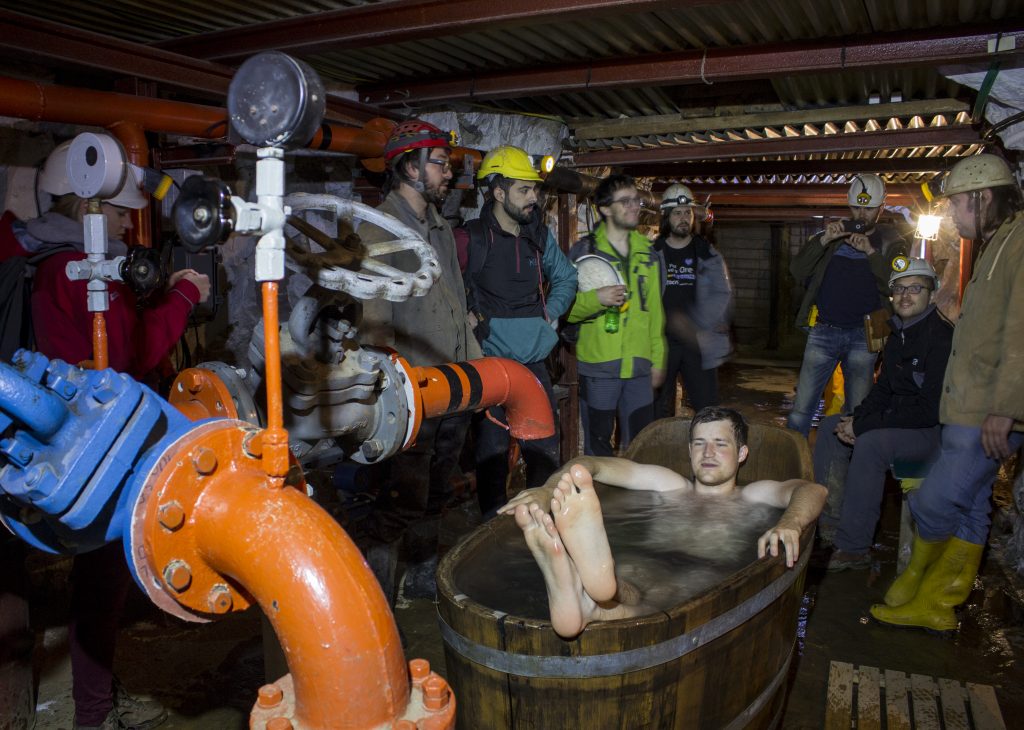
Fig.
7: Taking bath in warm radioactive spring Běhounek directly in
Svornost mine more than 500 m below the surface level. Photo by L.
Kyrc.
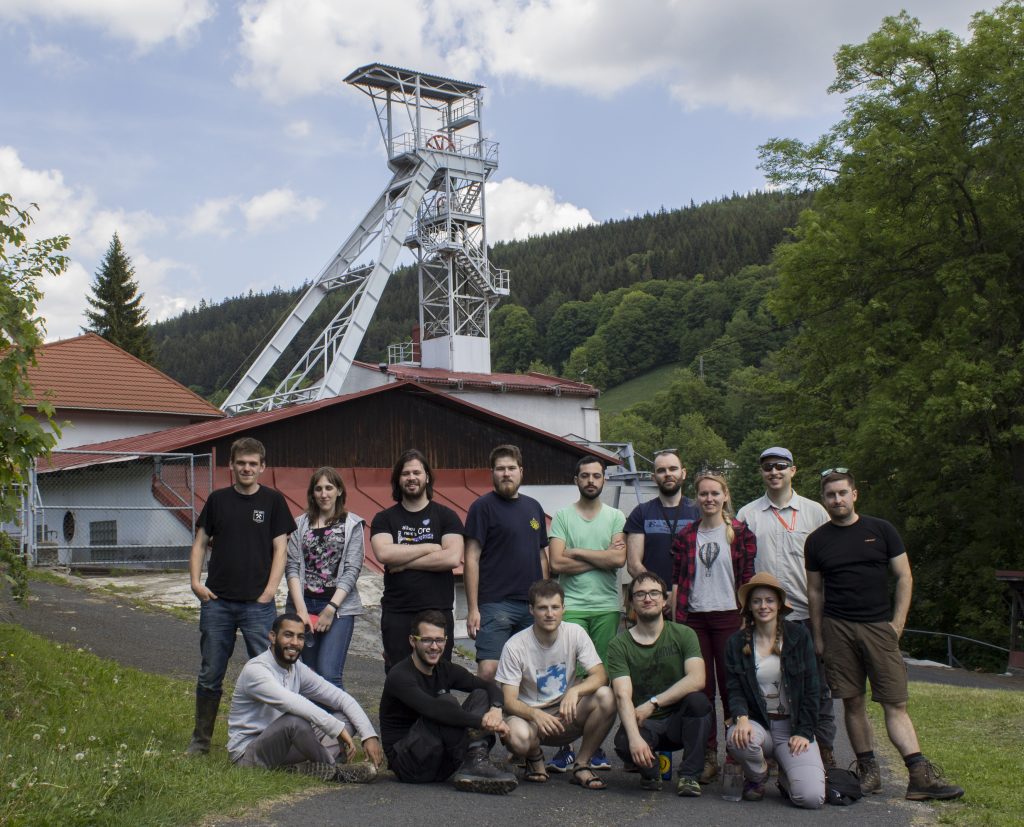
Fig.
8: Group photo in front of Svornost mine. Photo by L. Kyrc.
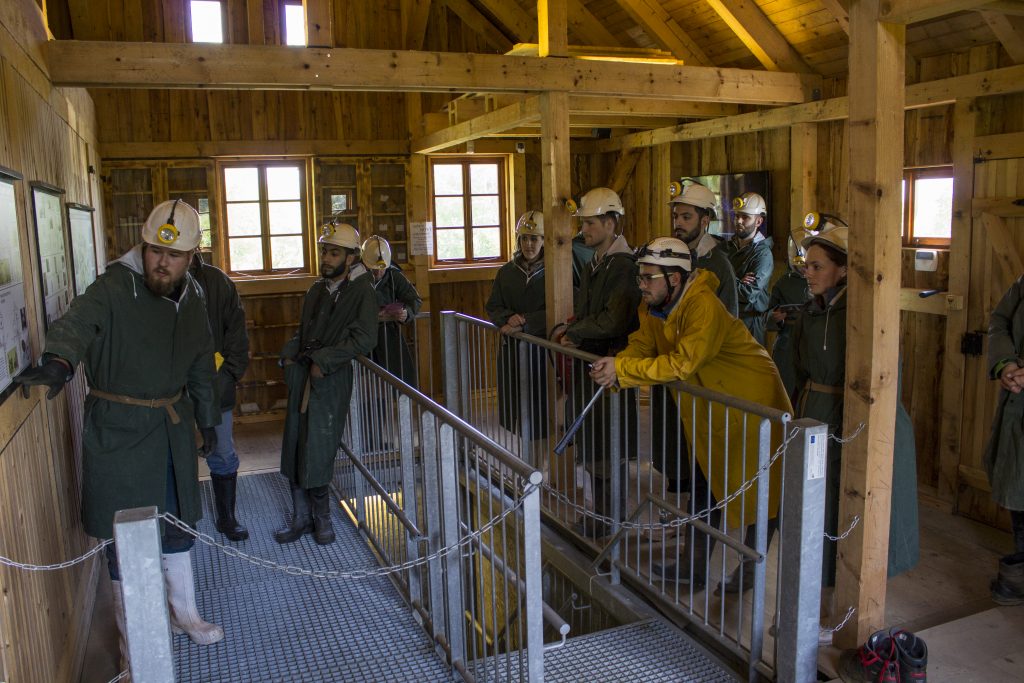
Fig.
9: Introduction talk in Mauritius mine. Photo by L. Kyrc.
3rd day
On the last day, we firstly visited an open-pit mine and processing of gem-quality pyropes, which are famous under the name “Czech garnet”. Czech garnet separating plant and the open-pit mine (Fig. 10), called Panské jámy, are situated close to the Podsedice village in the České Středohoří area (Central Bohemian Uplands – a neovolcanic field on the north of Czech Republic). There are approved reserves with a garnet content of about 40 g/m3. Garnets are mined easily by excavators from alluvial sediments, but originally, garnets come from near volcanic spots (diatremes), whose breccia filler contains blocks of serpentinized peridotite rich in those garnets. After separating garnets with the proper size and quality, they are sent for cutting and are used in the famous jewellery made by the company Granát Turnov.
After the garnets, we moved to the northern part of Krušné hory Mts., where we visited Krupka town surroundings in one of the youngest mining districts in this area named Knöttel (Bohosudov) situated on the east of Krupka area. The underground mining in this region, started in the 18th century. The deposit was formed in gneisses and was mainly exploited for tin and molybdenum mineralization. We started our tour close to the Barbora gallery, one of the molybdenum mine galleries exploited during World War 2. Then, we stopped near Siebenschläfer, a modern gallery with tin, copper and bismuth mineralization mined mainly for cassiterite. Next stop was on an old heap with high contents of native bismuth accompanied by chalcopyrite (Fig. 11). Another nearby stop was the Zwickenpinge, an open-pit with small shafts and heap with secondary copper mineralization and the first place of surface mining of tin and copper ores originated in 13th century. We also visited an open-pit above Prokop gallery, molybdenum mine with quartz body and greisen vein with occurrences of molybdenite, fluorite, topaz etc. The last stop was at the place where the quartz vein called Lukáš surfaces and where it was possible to find samples of green apatite crystals up to 1 cm, tin-rich mica zinnwaldite and some fluorite crystals.
Finally, we would like to thank all the leaders of the separate trips, especially to Dr. Pavel Škácha from the Pepř mine in Jílové district and Dr. Jakub Plášil and Dr. Viktor Goliáš for leading the trips to Svornost mine in Jáchymov. Special thanks to the Svornost mine and company Granát Turnov for allowing us to explore their mines and also to all the sponsors mentioned above.
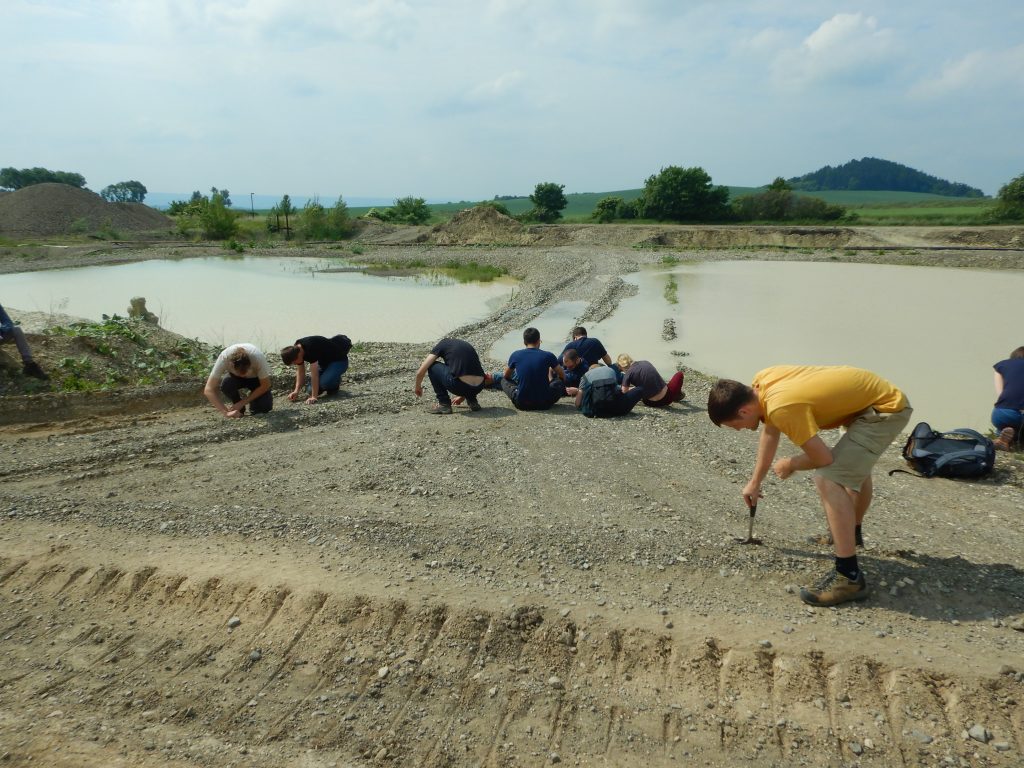
Fig.
10: Collecting of small gem-quality pyropes in the open-pit mine near
Podsedice village. System of cascades for cleaning processing waters.
Photo by J. Mysliveček.
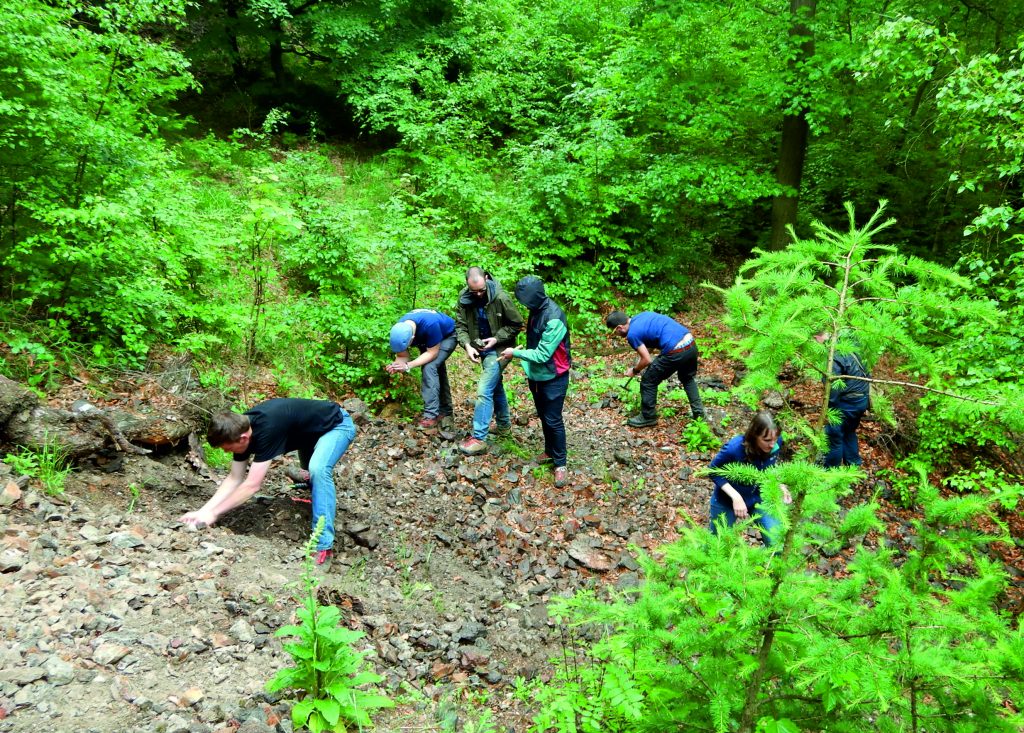
Fig.
11: Collecting samples on the heap rich on native bismuth. Photo by
J. Mysliveček.

